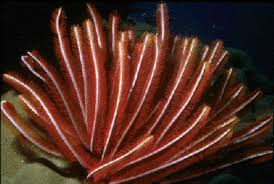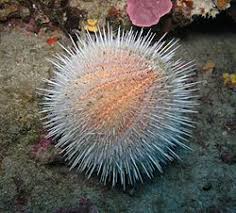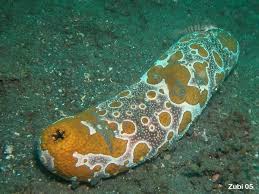Monday, June 11, 2012
Friday, March 2, 2012
Sem 2 Week 4 Describe how a nephron works. How is this similar to counter currents or hydrostatic skeletons?
Nephron is the basic function unit of a kidney. Each kidney has about 1 million nephrons, all packed into an area of the kidney called the cortex.
The main function of the nephron is to regulate concentration of water and soluble substances like sodium salts by filtering blood, reabsorbing what is needed and excreting the rest as urine. It eliminates wastes from the body, which in turn regulates blood volume and blood pressure, regulating blood pH.
The nephron carries out all of the kidney's functions.
Blood enters the kidney from the renal artery and moves into the glomerulus. This is where filtration occurs. The filtrate contains water and other toxic substances. The glomerulus is enclosed by the Bowman's capsule so only water and small molecules can pass through this area. The filtrate is then collected in the Bowman's capsule for transport through the nephron.
Fluid in the filtrate entering the proximal convoluted tubules is reabsorbed into capillaries. In the proximal tubule, tubular reabsorption occurs. Tubular reabsorption is when the cells in the proximal tubule remove water and nutrients from the filtrate and pass them back into the blood. The filtrate flows from the proximal tubule into the loop of Henle. The loop of Henle extends from the proximal tubule. It receives filtrate from the proximal convoluted tubule and exit into the distal convoluted tubule. The primary role of the loop of Henle is to concentrate the salt in the interstitium (tissue surrounding the loop). The distal convoluted tubule excrete more sodium and secretes hydrogen and ammonium to regulate pH. The process of tubular secretion occur in the distal tubule. During tubular secretion, wastes that were not initially filtered out in the bowman's capsule are removed from the blood in the distal tubule. Each distal convoluted tubule delivers its filtrate to a system of collecting ducts. The collecting duct system prepares the urine for transport out of the body. it is collected in the renal pelvis where it eventually enters the ureter and goes to the bladder.
The capillaries twisted around the nephron join back to the renal vein and become part of the ciculatory system.

http://images.wikia.com/analytical/images/f/fe/Nephron.jpg
The main function of the nephron is to regulate concentration of water and soluble substances like sodium salts by filtering blood, reabsorbing what is needed and excreting the rest as urine. It eliminates wastes from the body, which in turn regulates blood volume and blood pressure, regulating blood pH.
The nephron carries out all of the kidney's functions.
Blood enters the kidney from the renal artery and moves into the glomerulus. This is where filtration occurs. The filtrate contains water and other toxic substances. The glomerulus is enclosed by the Bowman's capsule so only water and small molecules can pass through this area. The filtrate is then collected in the Bowman's capsule for transport through the nephron.
Fluid in the filtrate entering the proximal convoluted tubules is reabsorbed into capillaries. In the proximal tubule, tubular reabsorption occurs. Tubular reabsorption is when the cells in the proximal tubule remove water and nutrients from the filtrate and pass them back into the blood. The filtrate flows from the proximal tubule into the loop of Henle. The loop of Henle extends from the proximal tubule. It receives filtrate from the proximal convoluted tubule and exit into the distal convoluted tubule. The primary role of the loop of Henle is to concentrate the salt in the interstitium (tissue surrounding the loop). The distal convoluted tubule excrete more sodium and secretes hydrogen and ammonium to regulate pH. The process of tubular secretion occur in the distal tubule. During tubular secretion, wastes that were not initially filtered out in the bowman's capsule are removed from the blood in the distal tubule. Each distal convoluted tubule delivers its filtrate to a system of collecting ducts. The collecting duct system prepares the urine for transport out of the body. it is collected in the renal pelvis where it eventually enters the ureter and goes to the bladder.
The capillaries twisted around the nephron join back to the renal vein and become part of the ciculatory system.
http://images.wikia.com/analytical/images/f/fe/Nephron.jpg
Thursday, March 1, 2012
Sem 2 Week 5 Why is it important to define and debate our understanding of intelligence and its origins? How does this relate to you?
People always questioned intelligence and always debated on what is intelligence. We often feel the comfort in tell other people that they are smart because they get good grades and know the answer to ever single question. However, there is more than intelligence than just getting the grade. There are other intelligence out there, such as musical talent and being artistic. Some people may be more street smart, but some people can be book smart. I think it is important to define and debate our understanding of intelligence and its origin because it will help us determine what is truly intelligence and how to determine what true intelligence is. If we can determine intelligence, we can improve ourselves in intelligence. Even now, we cannot define intelligence. If through genetics, we can determine whether intelligence is nurture or nature, we can truly understand who is truly intelligence and whether education is truly needed to create an intelligent person.
This related to me because by defining intelligence, we can improve our education to get the max out of it. I feel like we will learn faster if we grasp the essence of whether intelligence will increase if education exist. Perhaps, intelligence is purely nature, and education cannot help us later in life. By defining intelligence, schools can be more effective and education will improve.
This related to me because by defining intelligence, we can improve our education to get the max out of it. I feel like we will learn faster if we grasp the essence of whether intelligence will increase if education exist. Perhaps, intelligence is purely nature, and education cannot help us later in life. By defining intelligence, schools can be more effective and education will improve.
Sem 2 Genome Chapter 6 Summary: Intelligence
People have always questioned the test of intelligence. Ridley introduces the search for the intelligence gene. A study done on the genes of a group of high-IQ children found a difference on the gene IGF2R on chromosome 6. Ridley concluded that intelligence genes do not work in a vaccum. Studies done on separated twins have shown that there is heritability to intelligence and personality. Ridley introduced the concept that the intelligence genes are indeed more expressive later in life rather than less expressive because people begin to choose their own environments and comfort zones. A study show in the elementary school children in Head Start programs are no longer ahead of their peers by the end of elementary school. A counterargument to the study show that genes are even more expressive in egalitarian environments.
Sem 2 Genome Chapter 5 Summary: Environment
In chapter 5 of Genome, the tone of the writing changes to cynical. Ridley explains that the world of genetics is not just black and white. Genetic inheritance is based on the principles of pleiotropy, pluralism, and the environment of the individual. The asthma gene exist on chromosome 5 leads to the disorder, but the disorder also has a direct relationship with allergies. There are many theories on the increase of asthma. Some believes that pollution from modern synthetic chemicals such as isocyanates, excessive hygiene and others. The asthma causing gene are the two genes that produce immunoglobulin-E, which comes in different forms and is involved with the release of histamine into the body. Although asthma has been linked to genes, the genes isolated are trivial and inconclusive. The cause of the disease is usually attributed most to the environment of the individual.
Thursday, February 16, 2012
Sem 2 Week 3 Starfish Description
Starfish is classified under the phylum Echinodermata.
Symmetry
A starfish typically possess a 5-rayed symmetry. Most starfish have a radical symmetry, but some has bilateral symmetry.
Germ cell layers
The body wall of echinoderms consists of three layers. The outer layer is called the epidermis, which is a single layer of cells which covers the entire animal including its various spines. The middle layer is much thicker compare to the epidermis, which is called the dermis. The dermis is composed of connective tissue and contains the exoskeleton. This exoskeleton takes three different forms: a set of closely joined plates with little individual movement that exist as a test or shell, a set of separarely ariculating small plates called ossicles, and a collection of widely separated microscopic ossicles lying in the dermis. The ossicles are always made from calcite. The exoskeleton of echinoderms grows continuously throughout the animals life. The exoskeleton supports the spines, warts, and tubercles that are often found on the echinoderm surface. These various protuberances are also generally made from calcite. The third layer is also a single layer of cells. The main difference is that these cells are ciliated. This layer enclosed the animal's coelom separating the animal's guts from its skin (called coelomic lining).
Coelom
Starfish has a true coelom body cavity.
Circulatory system
Echinodermata has a poorly defined open circulatory system and posses a water vascular system, which hydraulically operates the tube feet or feeding tentacles. Echinoderm contact with the external world through its water vascular system. The water vascular system of the echinoderms is unique in the living world and easily distinguishes them from all other phyla. The system takes slightly different forms in the different classes. In the Crinoidea, which are believed to be the most ancient of the echinoderms, the tube feet are branched and secrete mucous. In the Ophiuroidea the tube feet are simple and slender. In Asteroidea, Echinoidea and Holothuroidea they are thicker and end in suckers. The water vascular system starts with an opening to the external environment called a madreporite. From this a short straight canal called the 'stone canal' leads to the 'ring canal'. The ring canal is a ring as might be expected and it has five longitudinal canals branching off from it into each of the arms, or their morphological equivalents in Echinoidea and Holothuroidea.
Reproduction
Starfish reproduce sexually and gonochoristically. Fertilization is always external. The larvae are planktonic and biradial. Develop into pentaradial symmetry as adults.
Feeding
Most Echinodermata possesses a through gut with an anus. The gut is U-shaped in the Crinoidea with the mouth and anus being on the same surface. Other groups have straight-through gut with mouth and anus on opposite sides. They are filter feeders. Echinodermata feeds on fine particles in the water, detritus, or other animals living in marine environment.
Excretion
Without excretion organ. Use the water vascular system to excrete waste. Many uses their tube feet as organs for gaseous exchange.
Nervous system
The nervous system includes a circum-oesophageal ring. Echinoderms have sub-epidermal nerve net running all over their body. They also have a circum-oral nerve ring with 5 radial nerve cords, connecting sub-epidermal nerve net.
Crinoidea (Sea lilies, feather stars, and comatulids)

http://www.ucmp.berkeley.edu/echinodermata/comatulid.gif
Ophiocistioidea (a class of extinct echinoderms, similar to sea urchin)

http://www.geomuseum.uni-goettingen.de/people/mreich/pdf/images/neuweb_seegurken11.gif
Astroidea (starfish)

https://blogger.googleusercontent.com/img/b/R29vZ2xl/AVvXsEhmx6YMSalSQSdg5CV0sDOvRGKSfQJjKZWdXQ0blakoFUdpDJxezl-8lwjKJDpWW0D5hbDo2peBv_QVf4N-dTVNxdII3aOZ7BbTsw5m9zfe37ANY7iWUhYq0vXp4O2o3rSpwDAtpKcSCwkW/s1600/5284ba28ba80d72f.jpg
Echinoidea (sea urchin, sand dollars are closely related)

http://upload.wikimedia.org/wikipedia/commons/thumb/4/4b/Riccio_Melone_a_Capo_Caccia_adventurediving.it.jpg/250px-Riccio_Melone_a_Capo_Caccia_adventurediving.it.jpg
Holothuroidea (sea cucumbers)

http://madmikesamerica.com/wp-content/uploads/2011/05/Bohadschia-argus1.jpg
Symmetry
A starfish typically possess a 5-rayed symmetry. Most starfish have a radical symmetry, but some has bilateral symmetry.
Germ cell layers
The body wall of echinoderms consists of three layers. The outer layer is called the epidermis, which is a single layer of cells which covers the entire animal including its various spines. The middle layer is much thicker compare to the epidermis, which is called the dermis. The dermis is composed of connective tissue and contains the exoskeleton. This exoskeleton takes three different forms: a set of closely joined plates with little individual movement that exist as a test or shell, a set of separarely ariculating small plates called ossicles, and a collection of widely separated microscopic ossicles lying in the dermis. The ossicles are always made from calcite. The exoskeleton of echinoderms grows continuously throughout the animals life. The exoskeleton supports the spines, warts, and tubercles that are often found on the echinoderm surface. These various protuberances are also generally made from calcite. The third layer is also a single layer of cells. The main difference is that these cells are ciliated. This layer enclosed the animal's coelom separating the animal's guts from its skin (called coelomic lining).
Coelom
Starfish has a true coelom body cavity.
Circulatory system
Echinodermata has a poorly defined open circulatory system and posses a water vascular system, which hydraulically operates the tube feet or feeding tentacles. Echinoderm contact with the external world through its water vascular system. The water vascular system of the echinoderms is unique in the living world and easily distinguishes them from all other phyla. The system takes slightly different forms in the different classes. In the Crinoidea, which are believed to be the most ancient of the echinoderms, the tube feet are branched and secrete mucous. In the Ophiuroidea the tube feet are simple and slender. In Asteroidea, Echinoidea and Holothuroidea they are thicker and end in suckers. The water vascular system starts with an opening to the external environment called a madreporite. From this a short straight canal called the 'stone canal' leads to the 'ring canal'. The ring canal is a ring as might be expected and it has five longitudinal canals branching off from it into each of the arms, or their morphological equivalents in Echinoidea and Holothuroidea.
Reproduction
Starfish reproduce sexually and gonochoristically. Fertilization is always external. The larvae are planktonic and biradial. Develop into pentaradial symmetry as adults.
Feeding
Most Echinodermata possesses a through gut with an anus. The gut is U-shaped in the Crinoidea with the mouth and anus being on the same surface. Other groups have straight-through gut with mouth and anus on opposite sides. They are filter feeders. Echinodermata feeds on fine particles in the water, detritus, or other animals living in marine environment.
Excretion
Without excretion organ. Use the water vascular system to excrete waste. Many uses their tube feet as organs for gaseous exchange.
Nervous system
The nervous system includes a circum-oesophageal ring. Echinoderms have sub-epidermal nerve net running all over their body. They also have a circum-oral nerve ring with 5 radial nerve cords, connecting sub-epidermal nerve net.
Crinoidea (Sea lilies, feather stars, and comatulids)
http://www.ucmp.berkeley.edu/echinodermata/comatulid.gif
Ophiocistioidea (a class of extinct echinoderms, similar to sea urchin)
http://www.geomuseum.uni-goettingen.de/people/mreich/pdf/images/neuweb_seegurken11.gif
Astroidea (starfish)
https://blogger.googleusercontent.com/img/b/R29vZ2xl/AVvXsEhmx6YMSalSQSdg5CV0sDOvRGKSfQJjKZWdXQ0blakoFUdpDJxezl-8lwjKJDpWW0D5hbDo2peBv_QVf4N-dTVNxdII3aOZ7BbTsw5m9zfe37ANY7iWUhYq0vXp4O2o3rSpwDAtpKcSCwkW/s1600/5284ba28ba80d72f.jpg
Echinoidea (sea urchin, sand dollars are closely related)
http://upload.wikimedia.org/wikipedia/commons/thumb/4/4b/Riccio_Melone_a_Capo_Caccia_adventurediving.it.jpg/250px-Riccio_Melone_a_Capo_Caccia_adventurediving.it.jpg
Holothuroidea (sea cucumbers)
http://madmikesamerica.com/wp-content/uploads/2011/05/Bohadschia-argus1.jpg
Sem 2 Week 3 Genome Chapter 3 Summary: History
In chapter 3 of Genome by Matt Ridley, Ridley introduces Dr. Archibald Garrod who published a hypothesis in 1902 called "the inborn errors of metabolism" through his research with the disease alkaptonuria. During the experiments, he assumed that each gene produced one chemical catalyst. The invorn errors of metabolism were caused by genetic mutations, which he described as "loss or malfunction of an enzyme" and that proteins manage virtually every function in the body. Dr. Garrod's thesis was well received, but all the readers missed the point. Both Mendel and Darwin was confused about genetics and mutations. Later discoveries about mutations revealed that genes codes for proteins and mutations were altered proteins made by altered genes. The structure of DNA was discovered by Watson and Crick in 1953. Crick coined the term genome. In 1995, scientists return to alkaptenuria and found it is caused by a single base substitution.
Subscribe to:
Posts (Atom)
